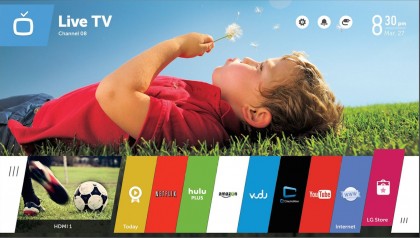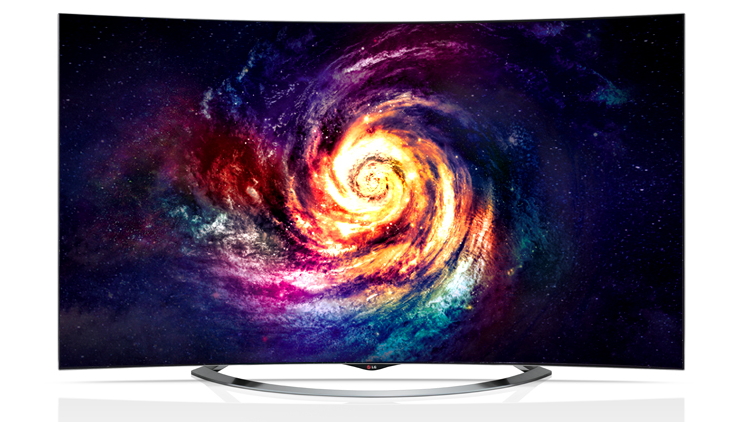TechRadar Verdict
If you're lucky enough to have six grand to spare you're faced with a stark TV choice between the LG 65EC970V and the Samsung UE65JS9500. Whichever way your money ultimately goes, though, the bottom line is that the 65EC970V is another ground-breaking moment for TV picture quality.
Pros
- +
Jaw-dropping design
- +
Unprecedented contrast performance
- +
webOS works brilliantly
- +
Surprisingly good sound
Cons
- -
Limited HDR options
- -
Needs accurate set up
- -
Not exactly cheap
- -
UHD upscaling only solid
Why you can trust TechRadar
If you're even remotely interested in home entertainment technology, you'll recognise the LG 65EC970V as potentially one of the biggest things to happen to television since the arrival of HD.
In fact, many people who've seen the combination of OLED technology and native UHD resolution at any preview over the past couple of years may well be harbouring hopes that it's as close to perfection as any TV has ever got before. Including Pioneer's legendary final-generation plasma TVs.
The thing is - like plasma technology, and unlike LCD - OLED technology is a self-emissive technology.
Each and every pixel in an OLED screen can produce its own individual light level and colour. There's no need to share an external light source between groups or even all pixels as happens with LCD technology.
Even direct LED TVs that place their lights behind the screen can't deliver light down to anywhere near pixel levels of accuracy like OLED can.
Obviously OLED's self-emissive nature raises the potential of contrast performances far beyond anything LCD is capable of - and all the demos we've seen to date have done nothing to dent our enthusiasm about this potential. In fact, OLED's contrast performance blew us away in full test conditions too when we took a look at LG's 55EC930V.
One issue with that 55-inch model, though, was that its 'mere' HD resolution led to a rather pixellated look to its pictures at times.
Sign up for breaking news, reviews, opinion, top tech deals, and more.
Hence our frankly giddy excitement at the prospect of OLED's contrast charms being partnered with a native 4K UHD resolution for the first time. Our excitement at the arrival of the 65EC970V isn't exactly quelled by its design.
It is, in short, the most gorgeous TV we've ever seen.

Its curved design is typically pretty (we'll get into potential practical issues associated with curved screens later), the way its incredibly narrow frame and screen share the same single 'plane' gives it a beautiful premium finish, and best of all the slenderness of much of its rear panel is nothing short of mind boggling.
There's barely a couple of millimetres between the screen and the outside of the rear panel, making you marvel at how such a design can even exist, as well as making all LCD TVs look positively fat by comparison.
Given the uninspiring state of built-in audio with many of today's flat TVs, it's hard not to fear a sonic downside to the 65EC970V's slimness given the simple lack of space for any speakers.
However, the 65EC970V somehow carries a claimed 40W sound system designed by audio luminary Harman Kardon, so hopefully it won't sound rubbish after all.
A slightly chunkier section of the TV's rear carries its connections.
These are decently numerous, including the now-expected highlights of four HDMI inputs (including support for 4K UHD feeds at up to 60 frames a second); a trio of USBs for recording from the built-in tuners or playing back multimedia from USB devices; and both integrated Wi-Fi and LAN network options.
These network options can be used for streaming multimedia from networked DLNA devices, or for accessing the online services that form part of LG's webOS smart TV system.
These services include most of the UK's favourite streaming services, such as Netflix, Amazon Instant, the BBC iPlayer, and Now TV (a service still not found elsewhere in the Smart TV world).
The only major absentees are the ITV Player and 4OD.
The most significant point about webOS, though, is its interface. This revolutionised the smart TV world when it launched last year thanks to its ground-breaking icon-driven design, laser-like focus on putting your favourite content at your finger tips, and treatment of all sources as apps.

Oddly the 65EC970V only currently carries 2014's version of webOS rather than the 2015 v2.0 version other 2015 LG TVs carry. But even an old webOS is still excellent, and in any case LG assures us that it will be updating the 65EC970V to webOS 2.0 via a firmware update in the coming weeks or months.
Looking for picture quality features beyond its key OLED/4K combination, the 65EC970V features what looks on paper like some fairly potent motion processing, built-in 3D (with a generous six pairs of glasses provided) using LG's passive system, and a solid array of picture calibration features.
The only eye-catching absentee from the 65EC970V's feature list is high dynamic range playback (which you do get with Samsung's similarly priced though LCD UE65JS9500s).
LG recently announced that it will be updating some of its new OLED TVs to accept HDR via streamed sources like Netflix and Amazon - but unfortunately the 65EC970V doesn't look as if it's going to be receiving this update.

John has been writing about home entertainment technology for more than two decades - an especially impressive feat considering he still claims to only be 35 years old (yeah, right). In that time he’s reviewed hundreds if not thousands of TVs, projectors and speakers, and spent frankly far too long sitting by himself in a dark room.
